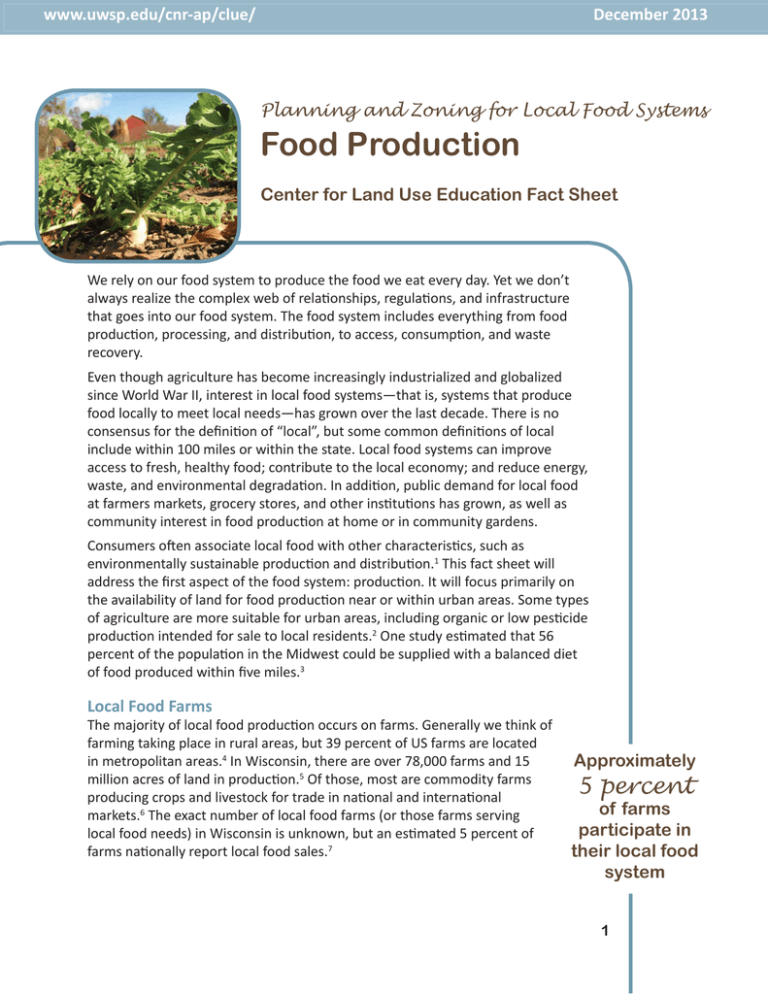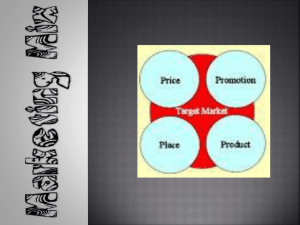Document 11957654
advertisement

www.uwsp.edu/cnr-ap/clue/ December 2013 Planning and Zoning for Local Food Systems Food Production Center for Land Use Education Fact Sheet We rely on our food system to produce the food we eat every day. Yet we don’t always realize the complex web of rela onships, regula ons, and infrastructure that goes into our food system. The food system includes everything from food produc on, processing, and distribu on, to access, consump on, and waste recovery. Even though agriculture has become increasingly industrialized and globalized since World War II, interest in local food systems—that is, systems that produce food locally to meet local needs—has grown over the last decade. There is no consensus for the defini on of “local”, but some common defini ons of local include within 100 miles or within the state. Local food systems can improve access to fresh, healthy food; contribute to the local economy; and reduce energy, waste, and environmental degrada on. In addi on, public demand for local food at farmers markets, grocery stores, and other ins tu ons has grown, as well as community interest in food produc on at home or in community gardens. Consumers o en associate local food with other characteris cs, such as environmentally sustainable produc on and distribu on.1 This fact sheet will address the first aspect of the food system: produc on. It will focus primarily on the availability of land for food produc on near or within urban areas. Some types of agriculture are more suitable for urban areas, including organic or low pes cide produc on intended for sale to local residents.2 One study es mated that 56 percent of the popula on in the Midwest could be supplied with a balanced diet of food produced within five miles.3 Local Food Farms The majority of local food produc on occurs on farms. Generally we think of farming taking place in rural areas, but 39 percent of US farms are located in metropolitan areas.4 In Wisconsin, there are over 78,000 farms and 15 million acres of land in produc on.5 Of those, most are commodity farms producing crops and livestock for trade in na onal and interna onal markets.6 The exact number of local food farms (or those farms serving local food needs) in Wisconsin is unknown, but an es mated 5 percent of farms na onally report local food sales.7 Approximately 5 percent of farms participate in their local food system 1 In Wisconsin, 6,243 farms sell direct to consumers through farmer’s markets, community-supported agriculture, or other outlets.8 In addi on, many local food farms sell through intermediated markets such as regional distributors, grocery stores, restaurants, or other retailers.9 Local food farms are more likely to be smaller in size, family-owned, and located in or near metropolitan coun es. As a result, local food farms may uniquely experience the pressures of development. Because of their size, local food farms can respond to local needs but may be limited by scale. In addi on, the producers are o en younger and have more formal educa on. As demand for local food grows, the number and/or size of local food farms may also need to grow to meet that demand. Many factors affect the types of products that producers grow and raise, such as climate, soil, cultural and personal preferences, and marke ng and distribu on networks. Many local food farms grow a wider variety of products than commodity farms. Most local food farms are vegetable, fruit, and nut farms, with a smaller percentage of local food farms producing other field crops or livestock.10 Local food farms o en dis nguish themselves by selling niche products, such as organics, or heirloom plant varie es or animal breeds. This allows them to generate higher gross sales per acre from smaller farms.11 For that reason, some local food farms may use less land than other types of farming. Most local food farms are located on private land, though a small number of local food farms are operated by nonprofits on publicly owned land in U.S. ci es.12 Non-Farm Food Produc on In addi on to farm produc on, some local produc on occurs off farm. For example, many households grow food for their own use. An es mated 31 percent of households par cipate in food gardening, mainly at their own homes but also at friends’, neighbors’, or rela ves’ homes, or at community Approximately gardens.13 There are over 100 31 percent documented community gardens of households in Wisconsin, and the list is 14 growing. In addi on to gardens, participate in some communi es are also food gardening star ng community orchards.15 Many communi es also have volunteer programs to grow food for people experiencing poverty, such as food pantry or church gardens, or Plant A Row for the Hungry. These types of nonfarm food produc on sites can be located on public or private land. For example, many schools are star ng gardens for student educa on and cafeteria use. “Traditionally planners have attempted to draw their lines between the urban and the rural, essentially creating areas of food production and food consumption. However, this dichotomy often proves to be an oversimplification and may be harmful to the socially desirable goal of sustainability.” Hemert and Holmes16 2 Planning There are several components of community planning in which local governments can consider and promote local food produc on. Build rela onships with food system partners in the community and region involved in local food produc on on farms and in your community. This may include: • Small and mid-size producers • Producer groups • Nonprofits • Ins tu ons Determine the best way to engage partners on an ongoing basis to address food produc on needs, such as through a food policy council, a standing or ad hoc commi ee, or regular communica on with appropriate staff. Gather data on local food produc on. For example: • Work with community and university partners to conduct a food system assessment that determines the boundary’s of the local foodshed.17 • Assess the pressure of development on agricultural land used for local food produc on. Conduct a land inventory assessment to iden fy public and private land suitable for local food produc on.18 • Par cipate in regional efforts to determine the land requirements, producers, and amount and types of product necessary to feed the local popula on.19 Address local food produc on in community plans including comprehensive, farmland preserva on, sustainability, and other plans.20,21 • Develop specific and measurable goals for local food produc on, considering both farm and non-farm produc on. • Iden fy ways to reduce barriers to local food produc on. Review zoning code. Provide in-kind or financial support for programs that enable area farmers to serve the local food system. • Recognize the benefits of food produc on in close proximity to urban centers. Iden fy and address areas suitable for long-term food produc on in your county’s farmland preserva on plan. • Promote mixed use development that includes neighborhood-level food produc on through home and community gardens and orchards, and raising micro-livestock such as chickens or bees.22 Model Comprehensive Plan Goal and Objec ves Comprehensive plan goals iden fy community priori es and set the direc on for future ac on. Include local food produc on in appropriate elements: Goal: Support local food producƟon that strengthens the local food system 1. Provide or support networking and educa onal opportuni es for local food producers and other food system partners 2. Address farm and non-farm local food produc on in the zoning code 3. Support beginning local food farmers by providing access to resources, such as affordable farmland 4. Provide food producers with market analysis to help them access local markets and meet local food needs 3 Regula on Local regula on affec ng food produc on primarily occurs through zoning and farmland preserva on. There are several areas in which local food produc on could be considered. Educate local government officials, staff, and the public about food produc on regula ons. Provide the informa on on local government websites. Specifically define components of local food produc on in the zoning code.23 Include both agricultural land such as farms and community gardens and accessory structures such as greenhouses, hoop houses, raised beds, fish tanks, chicken coops, rainwater collec on systems, etc.24,25 Review the zoning code and reduce unnecessary barriers to food produc on in each district (e.g., residen al, commercial, open space, and mixed use). • • Dis nguish between intensive, and less intensive, food produc on.26 A farm might make sense as a condi onal use in some districts, whereas a community garden might make sense as a permi ed use. • Allow micro-livestock in select districts with appropriate limita ons (e.g., allow hens but not roosters). Common regula ons address number and type of animals, allowable zones, site specifica ons such as lot size and setbacks and types of accessory structures, slaughtering, and disposal.29,30 Most zoning ordinances do not address slaughtering, except to note that it is banned. However, slaughtering is a means of disposal Permit home gardens in residen al districts and review landscaping requirements in all districts. Include regula ons that balance edible landscaping with maintenance standards and user rules.32 In addi on to farmland preserva on in general, consider ways to preserve or encourage food produc on in par cular. For example: • Create agricultural conserva on easements through local government or an area land trust that are specific to local food farms, community gardens, and orchards.33 • Support programs that provide resources to beginning local food farmers. Learn about ways municipali es, ins tu ons, and land trusts can lease land to farmers.34 Consider crea ng districts specifically for food produc on, such as urban agriculture districts in urban areas,27 or local food produc on districts on the development fringe.28 Use appropriate regula on, rather than outright bans, to address local food produc on nuisances. For example, • and an important cultural prac ce to some immigrant and refugee popula ons that can be regulated.31 Model Local Food Produc on District Local food produc on districts address agriculture on the development fringe. This district is focused on local, rather than commodity, food produc on. • Permi ed uses include produce farms, nurseries, greenhouses, community supported agriculture, community gardens, and so forth. • Provisional uses include animal husbandry, residen al food processing, and agricultural retail. • Condi onal uses include aquaculture, schools, community buildings, etc. 4 Examples in Wisconsin Below are examples of planning and zoning ac vi es related to local food produc on. Eau Claire Comprehensive Plan - Health Chapter h p://bit.ly/1hJcW8G In August 2013 the city of Eau Claire approved adding a new health chapter to their comprehensive plan. The chapter has six objec ves, including food and nutri on. Below are a few of the policies related to local food produc on that are included: • Increase the number of neighborhood and community gardens in public spaces. • Consider allowing limited animal husbandry while protec ng against possible associated nuisances. • Consider crea ng a master plan for the community’s food system. Urban Agriculture in Appleton www.appleton.org/municipal_code/ In 2012 the city of Appleton updated their zoning code to include urban agriculture. Defini ons were created for community gardens and urban farms. Neither defini on includes micro-livestock, which is being discussed separately. In addi on, the city added a new special use permit for urban farms, which are allowed in several districts (including residen al). This addi on was in response to nonprofit Riverview Gardens’ desire to redevelop an urban farm on an old golf course. A er submi ng a special use applica on that included an urban farm management plan, Riverview Gardens was approved to develop the farm on the 72-acre site, roughly a third of which will be used for intensive food produc on. Portage County Zoning Ordinance www.co.portage.wi.us/ordinances/Chapter%207.pdf Although considered a rural county, Portage County did not allow chickens in residen al districts un l 2010 when a group of residents encouraged the county to pass an ordinance. The Portage County Zoning Ordinance includes specific provisions for keeping chickens under Sec on VI. Up to 12 chickens are allowed in the R1, R2, and R5 residen al zoning districts. Roosters are prohibited and no slaughtering or butchering is allowed on site. The chicken coop must be 50 feet from any adjoining property line or well, and 100 feet from any neighboring residence. Conclusion Produc on of food for local and regional consump on represents a small, but growing, segment of Wisconsin food produc on. Communi es that engage in planning and zoning for their local food system may be be er prepared to address produc on issues related to land use. WriƩen by Kristy SeBlonka and Anna Haines, Center for Land Use EducaƟon. 2013. Reviewed by Lynn Markham and Becky Roberts, CLUE; Erin Peot, Center for Community and Economic Development; Carrie Edgar, Dane County UW-Extension; and Teresa Engel, Department of Agriculture, Trade, and Consumer ProtecƟon. PublicaƟon available on CLUE’s website: www.uwsp.edu/cnr-ap/clue. Photo credits: Sunny Sky Farm (front) and Riverview Gardens (above). 5 References 1 Mar nez, Steve, et al. May 2010. Local Food Systems: Concepts, Impacts, and Issues. USDA Economic Research Report 97. 2 Markham, Lynn. Farming Subdivisions: Problema c or Promising? Land Use Tracker. Winter 2007. 3 The study es mated the “per capita” cropland requirement in the Midwest, taking into considera on the distance between popula on centers and cropland, varia ons in yield among 40 crops grown in the Midwest, and targeted dietary recommenda ons. See Hu, Guiping, Wang, Lizhi, Arendt, Susan, and Randy Boeckenstedt. Fall 2011. “An Op miza on Approach to Assessing the Self-Sustainability Poten al of Food Demand in the Midwestern United States.” Journal of Agriculture, Food Systems, and Community Development. Volume 2, Issue 1. 4 Metropolitan areas have an urban popula on center of over at least 50,000. 5 Na onal Agricultural Sta s cs Services. 2011 State Agriculture Overview: Wisconsin. 6 While the term “commodity” has been used more broadly in recent years, the authors use it in its tradi onal sense in regards to trade in na onal and interna onal markets. 7,9,10,11 Low, Sarah A. and Stephen Vogel. November 2011. “Direct and Intermediated Marke ng of Local Foods in the United States.” USDA Economic Research Report 128. 8 USDA Census of Agriculture. 2007 Wisconsin Data. Available at www.agcensus.usda.gov/Publica ons/2007/Full_Report/Volume_1,_Chapter_1_ State_Level/Wisconsin/. 12 For an example, see the Incubator Farm Project in North Carolina at www.cefs.ncsu.edu/whatwedo/foodsystems/incubatorfarmproject.html. 13 Na onal Gardening Associa on. 2009. 14 UW-Extension. FEEDS website. Accessed at h p://feeds.uwex.edu/index.cfm. 15 See Ames, Guy. May 2013. Community Orchards. Available at h ps://a ra.ncat.org/publica on.html#hor cultural. 16 Hemert, James van, and Joe Holmes. 2007. Pu ng Sustainable Community Development in Context: A Look at the Food System. Rocky Mountain Land Use Ins tute. 17 Freedgood, Julia, Pierce-Quiñonez, Marisol, and Kenneth A. Meter. December 2011. Emerging assessment tools to inform food system planning. Journal of Agriculture, Food Systems, and Community Development. p. 86-88. 18 Most Wisconsin agricultural land is for commodity crops. See page 4 in the Center for Land Use Educa on’s Wisconsin Land Use Megatrends Agriculture, available at www.uwsp.edu/cnr-ap/clue/Pages/publica ons-resources/LandUseMegatrends.aspx. 19 An example of a land use assessment that considers a regional diet is the Western Lake Superior Region diet. More informa on can be found at www.superiorfoodweb.org/LAFS/HFHL_FINALREPORT.pdf. 20 See ac ons by component in Roberts, Rebecca. Planning for Community Food Systems. Land Use Tracker. Winter 2007. 21 Find a link to your community’s comprehensive plan on the Department of Administra on’s website: h p://bit.ly/1fVZaLP. 22 Mixed use development is generally thought of as a mix of residen al and commercial, but can be broadened to agriculture, recrea on, and other uses. 23 ChangeLab Solu ons provides some defini ons for urban agriculture. See Wooten, Heather (ChangeLab Solu ons). October 2011. Seeding the City: Land Use Policies to Promote Urban Agriculture. 24,27,33 Harvard Law School Food Law and Policy Clinic. July 2012. Good Laws, Good Food: Pu ng Local Food Policy to Work for Our Communi es. 25 Obtain a copy of the local zoning code from your local municipality. Most Wisconsin ci es, villages, and coun es have adopted general zoning. Towns may par cipate in county zoning, or have their own general zoning if the county does not. See Roberts, Rebecca and Lynn Markham. 2007. Planning Implementa on Tools: Zoning Ordinances. CLUE. 26 See Mukherji, Nina, and Alfonso Morales (American Planning Associa on). March 2010. Prac ce Urban Agriculture. Zoning Prac ce, Issue 3. 28 Ross, Brian (CR Planning, Inc.). 2008. Local Food Networks. Updated Model Ordinances for Sustainable Development. MPCA. 29 Typical types of micro-livestock include chickens, bees, and goats. See Bouvier, Jaime (American Planning Associa on). April 2013. Prac ce Urban Livestock. Zoning Prac ce. Issue 4. 30 Butler, William. February 2012. Welcoming Animals Back to the City: Naviga ng the Tensions of Urban Livestock through Municipal Ordinances. Journal of Agriculture, Food Systems, and Community Development. Volume 2, Issue 2. 31 See Burlington Urban Agriculture Task Force Report for recommenda ons for a slaughtering ordinance, including how to manage waste, disposal, and sitelines. Available at h p://burlingtonfoodcouncil.org/our-projects/ua /. 32 Ross, Brian (CR Planning, Inc.). 2008. Landscaping and Maintenance of Vegeta on. Updated Model Ordinances for Sustainable Development. Minnesota Pollu on Control Agency (MPCA). 34 To learn more, see Land for Good. Leasing Land to Farmers: A Handbook for New England Land Trusts, MunicipaliƟes, and InsƟtuƟons.





